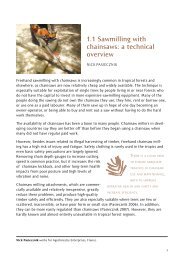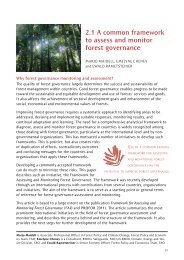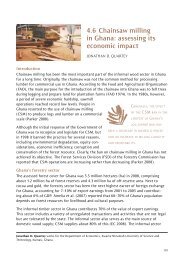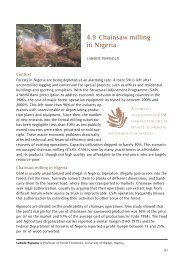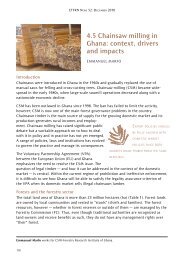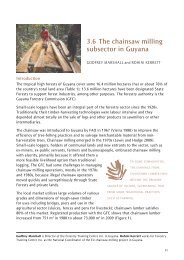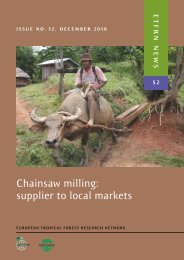Chainsaw milling: supplier to local markets - European Tropical ...
Chainsaw milling: supplier to local markets - European Tropical ...
Chainsaw milling: supplier to local markets - European Tropical ...
You also want an ePaper? Increase the reach of your titles
YUMPU automatically turns print PDFs into web optimized ePapers that Google loves.
178<br />
ETFRN NEws 52: DEcEmbER 2010<br />
• the FDa’s capacity for effective law enforcement is very limited;<br />
• apart from the collection of waybill fees, the fiscal regime established for commercial<br />
logging is not applied <strong>to</strong> Csm —immunity from fees has made Csm extremely<br />
profitable, which is a strong incentive for people <strong>to</strong> invest in the sec<strong>to</strong>r, resulting in<br />
its rapid expansion;<br />
• a strong market demand exists for post-war reconstruction materials; and<br />
• Csm generates employment.<br />
impacts of chainsaw <strong>milling</strong> in liberia<br />
Socio-economic impacts<br />
Benefits <strong>to</strong> communities and individuals<br />
The lack of any structured distribution or management of benefits means that inequities<br />
are common. Communities and individuals receive direct benefits from Csm in the form of<br />
cash or in-kind payments from chainsaw millers or businessmen. individuals benefit from<br />
wages, which average about us$189 per month per person and can be as much as<br />
us$93,000 per year per community. Communities may benefit indirectly from the removal<br />
of large trees from agricultural land. Farms created in this manner are two or three times<br />
larger than traditional slash-and-burn areas. purchasing power is increased through the<br />
employment of <strong>local</strong> people. This in turn results in the emergence of small businesses in<br />
the vicinity of Csm.<br />
community conflicts<br />
The large flows of benefits derived from Csm by both communities and county authorities<br />
are usually accompanied by inadequate accountability, misappropriation of funds,<br />
inequities in benefit sharing and thefts of agricultural produce, planks, and bush meat<br />
from traps, which account for more than 70 percent of<br />
conflicts in the community. additional sources of conflict<br />
include delays in or refusal by chainsaw millers <strong>to</strong> make<br />
payments; harvesting trees without community authorization<br />
and domestic disruption caused by the high incidence<br />
of relationships between women from communities and<br />
chainsaw millers.<br />
Environmental impacts<br />
Forest structure<br />
The structure of the forest is being adversely affected.<br />
<strong>Chainsaw</strong> millers harvest nearly all trees of the desired species above 35-cm diameter at<br />
breast height (Dbh); the regulated minimum felling diameter is 40-cm Dbh for TsC areas<br />
and 60 cm Dbh for FmC areas. blackett, lebbie and marfo (2009) observed that the hiring<br />
of chainsaw opera<strong>to</strong>rs has increased the traditional farm size by about two <strong>to</strong> three times.<br />
in some high forest areas, valuable species such as Tetra, niangon and abura tend <strong>to</strong> occur<br />
in groups or pure stands. These three species, <strong>to</strong>gether with lovoa (Lovoa trichilioides),<br />
account for 75% of the species harvested. Csm’s low-Dbh felling limits — especially in<br />
areas where pure stands of the preferred species occur — will have an adverse effect on<br />
the future growth of forests.



